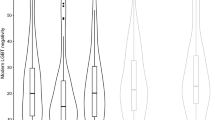ABSTRACT
This study examines the impact of two versions of anti-stigma programs—education and contact—presented on videotape. A total of 244 people were randomly assigned to education or contact conditions and completed pre-test, post-test, and follow-up measures of stereotypes. Results suggest that the education videotape had limited effects, mostly showing improvement in responsibility (people with mental illness are not to blame for their symptoms and disabilities). Watching the contact videotaped showed significant improvement in pity, empowerment, coercion, and segregation. Contact effects were evident at post-test and 1 week follow-up. Implications of these findings for future research are discussed.
Similar content being viewed by others
References
Bookbinder S. R. (1978). Mainstreaming-What every child needs to know about disabilities. Rhode Island Easter Seal Society, Providence, RI
Corrigan P.W., Lundin R. (2001). Don’t call me Nuts! Coping with the stigma of mental illness. Recovery Press, Tinley Park, IL
Corrigan P. W., Markowitz F. E., Watson A. C., Rowan D., Kubiak M. A. (2003). An attribution model of public discrimination towards persons with mental illness. Journal of Health and Social Behavior 44:162–179
Corrigan P. W., Penn D. L. (1999). Lessons from social psychology on discrediting psychiatric stigma. American Psychologist 54:765–776
Corrigan P. W., River L., Lundin R. K., Penn D. L., Uphoff-Wasowski K., Campion J., et al. (2001). Three strategies for changing attributions about severe mental illness. Schizophrenia Bulletin 27:187–195
Corrigan P. W., Rowan D., Green A., Lundin R., River P., Uphoff-Wasowski K., et al. (2002). Challenging two mental illness stigmas: Personal responsibility and dangerousness. Schizophrenia Bulletin 28:293–310
Corrigan P. W., Salzer M., Ralph R. O., Sangster Y., Keck L. (2004). Examining the factor structure of the recovery assessment scale. Schizophrenia Bulletin 30:1035–1041
Corrigan P. W., Watson A. C. (2003). Factors that explain how policy makers distribute resources to mental health services. Psychiatric Services 54:501–507
Desai M. M., Rosenheck R. A., Druss B. G., Perlin J. B. (2002). Mental disorders and quality of care among postacute myocardial infarction outpatients. Journal of Nervous and Mental Disease 190:51–53
Desai M. M., Rosenheck R. A., Druss B. G., Perlin J. B. (2002). Mental disorders and quality of diabetes care in the Veterans Health Administration. American Journal of Psychiatry 159:1584–1590
Druss B. G., Bradford D. W., Rosenheck R. A., Radford M. J., Krumholz H. M. (2000). Mental disorders and use of cardiovascular procedures after myocardial infarction. JAMA: Journal of the American Medical Association 283(4):506–511
Farina A., Felner R. D., Bourdreau L. A. (1973). Reactions of workers to male and female mental patient job applicants. Journal of Consulting and Clinical Psychology 41:363–372
Farina A., Thaw J., Lovern J. D., Mangone D. (1974). People’s reactions to a former mental patient moving to their neighborhood. Journal of Community Psychology 2:108–112
Gaertner S. L., Dovidio J. F., Bachman B. A. (1996). Revisiting the contact hypothesis: The induction of a common ingroup identity. International Journal of Intercultural Relations 20:271–290
Holmes E. P., Corrigan P. W., Williams P., Canar J., Kubiak M. (1999). Changing public attitudes about schizophrenia. Schizophrenia Bulletin 25:447–456
Kinderman P., Kaney S., Morley S., Bentall R. P. (1992). Paranoia and the defensive attributional style: Deluded and depressed patients’ attributions, about their own attributions. British Journal of Medical Psychology 65:4–10
Link B. G. (1987). Understanding labeling effects in the area of mental disorders: An assessment of the effects of expectations of rejection. American Sociological Review 52:96–112
Link B. G., Phelan J. C., Bresnahan M., Stueve A., Pescosolido B. A. (1999). Public conceptions of mental illness: Labels, causes, dangerousness, and social distance. American Journal of Public Health 89:1328–1333
Macrae C., Bodenhausen G. V., Milne A. B., Jetten J. (1994). Out of mind but back in sight: Stereotypes on the rebound. Journal of Personality and Social Psychology 67:808–817
MacRae C., Bodenhausen G. V., Milne A. B., Wheeler V. (1996). On resisting the temptation for simplification: Counterintentional effects of stereotype suppression on social memory. Social Cognition 14:1–20
National Mental Health Awareness Campaign. (2002). http://www.nostigma.org. Retrieved May, 2002
Page S. (1995). Effects of the mental illness label in 1993: Acceptance and rejection in the community. Journal of Health and Social Policy 7:61–68
Pate G. S. (1988). Research on reducing prejudice. Social Education 52:287–289
Pescosolido B. A., Monahan J., Link B. G., Stueve A., Kikuzawa S. (1999). The public’s view of the competence, dangerousness, and need for legal coercion of persons with mental health problems. American Journal of Public Health 89:1339–1345
Pettigrew T.F., Tropp L.R. (2000). Does intergroup contact reduce prejudice: Recent meta-analytic findings. In: Oskamp S. (eds), Reducing Prejudice and Discrimination. Lawrence Erlbaum & Assoc, Mahwah, NJ, pp. 93–114
Reinke R. R., Corrigan P. W., Leonhard C., Lundin R. K., Kubiak M. A. (2004). Examining two aspects of contact on the stigma of mental illness. Journal of Clinical and Social Psychology 23:377–389
Skitka L. J., Tetlock P. E. (1992). Allocating scarce resources: A contingency model of distributive justice. Journal of Experimental Social Psychology 28:491–522
Smith A. (1990). Social influence and antiprejudice training programs. In: Edwards J., Tindale R. S., Heath L., Posavac E. J. (eds), Social innfluence processes and prevention. Plenum, NewYork, pp. 183–196
Wahl O. F. (1999). Mental health consumers’ experience of stigma. Schizophrenia Bulletin 25:467–478
Weiner B. (1995). Lessons from the past. Psychological Inquiry 6:319–321
Author information
Authors and Affiliations
Corresponding author
Additional information
Patrick W. Corrigan and Jon Larson are affiliated with the Institute of Psychology, Illinois Institute of Technology, Chicago, IL, USA.
Molly Sells is affiliated with the University of Chicago, Chicago, IL, USA.
Nathaniel Niessen is affiliated with Northwestern University, Evanston, IL, USA.
Amy Watson is affiliated with the University of Illinois at Chicago, Chicago, IL, USA.
Rights and permissions
About this article
Cite this article
Corrigan, P.W., Larson, J., Sells, M. et al. Will Filmed Presentations of Education and Contact Diminish Mental Illness Stigma?. Community Ment Health J 43, 171–181 (2007). https://doi.org/10.1007/s10597-006-9061-8
Received:
Accepted:
Published:
Issue Date:
DOI: https://doi.org/10.1007/s10597-006-9061-8



